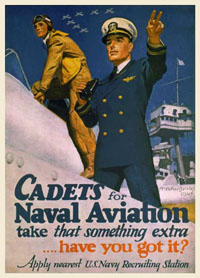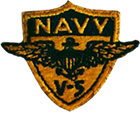The training pipeline from AvCad V-5 to Naval Aviator A-V(N)
During the build up of World War II, the United States' air forces suddenly found itself with the monumental task of training thousands of pilots needed to fight global war on two fronts in the European theater against Nazi Germany and the Pacific theater against the Empire of Japan. The immediate demand for U.S. pilots was so great that Congress waved the existing prerequisite of two or more years college. As long as you had a high school diploma, passed physical tests and mental exams, you could fly for Uncle Sam. It was also a great attraction to the many young male recruits dreaming of becoming pilots. In December 1942, Ed Scharch signed on as a volunteer recruit and began the first of several training stages to become a Naval Aviation Cadet under the United States Navy Reserve. Following physical exams and intensive aptitude tests, Ed Scharch was accepted by the U.S. Naval Aviation Cadet Selection Board and was sworn in as an AvCad V-5 candidate. Ed's first hurdle was to make it through "elimination school," the civilian pilot training program under the Civil Aeronautics Authority - War Training Service. |
|||||||||||||||||||||||||||||||||||||||||||||||||||||||||||||||||||||||||||||
Ed's Naval Aviation Training 1942-1944 |
|||||||||||||||||||||||||||||||||||||||||||||||||||||||||||||||||||||||||||||
|
Some details of the various training stages, schools and curriculum are from articles and personal accounts by other naval cadets and aviators during the war. These details, along with Ed's service records, give insight to his experiences. |
|||||||||||||||||||||||||||||||||||||||||||||||||||||||||||||||||||||||||||||
|
|
|
||||||||||
The Naval Aviation Cadet ProgramTo meet the demand for aviators the Navy created a cadet program similar to the Flight Officer program used by the Army. |
||||||||||
Naval Aviation Reserve Act (1939)On April 11, 1939, Congress passed the Naval Aviation Reserve Act, which expanded the parameters of the earlier Aviation Cadet Act. Training was for 12 months. Graduates would receive commissions in the Naval Reserve as an Ensign or the Marine Corps Reserve as a 2nd Lieutenant, and served an additional seven years on active duty. Uniforms and InsigniaDuring Basic and Ground School their duty uniforms
from 1935 to 1943 were green surplus Civilian
Conservation Corps (CCC) fatigue uniforms. Naval
Aviation Cadets wore the same dress uniforms as naval
officers once they completed Primary.
Naval Cadets wore a different insignia than Army Aviation Cadets: a yellow shield with a blue chief with the word "Navy" in yellow letters, a pair of Naval Aviator wings bordered and decorated in blue across the middle, and the letter/number "V-5" in blue in the base. The insignia was in enameled sterling silver for wear on the breast pocket of dress uniform jackets and cloth patch form for wear on uniforms. Graduates received gold-metal Naval Aviator's wings rather than the silver-metal wings awarded to Army Aviators. |
||||||||||
Years 1942 to 1945During the war, the USN pilot training program started to ramp up. It had similar stages as the army's aviation program, except it added a Carrier Qualification stage for fighter, torpedo and dive-bomber pilots. Each graduate had around 600 total flight hours, with approximately 200 flight hours on front-line Navy aircraft. In 1942 the program graduated 10,869 aviators, almost
twice as many as had completed the program in the previous 8
years. In 1943 there were 20,842 graduates; in 1944, 21,067;
and in 1945 there were 8,880. Thus in the period 1942 to
1945, the U.S. Navy produced 61,658 pilots - more than 2.5
times the number of pilots as the Imperial Japanese Navy. |
||||||||||
Training Phases for USN AvCads and Naval Aviators during WWII |
||||||||||
| The overall training timeline to prepare naval pilots for combat varied. | ||||||||||
|


